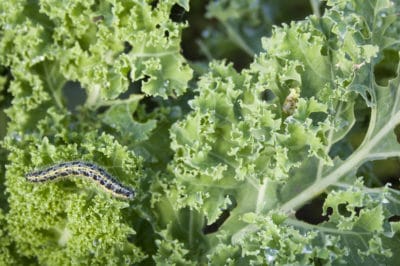Identifying The Caterpillars
The three different types of caterpillars you might find munching on your kale have one thing in common, the color green. They do have other distinguishing features, however.
Imported Cabbage Worms
These are the most common type of caterpillars found on kale. The eggs are laid by cabbage moths. The caterpillars are green with faint yellow stripes. Their bodies are lightly covered with fine, short hairs that provide a velvety look.
Cabbage Loopers
Cabbage loopers are yellow-green. Like inchworms, they have no legs in the middle of their bodies, so, like inchworms, their bodies loop up in the middle as they crawl. The eggs are laid by the mottled brown moths you might see flying around at dusk.
Diamondback Moth Caterpillars
These green caterpillars can be identified by the two stubby legs protruding from the rear. The moths are small and brownish with turned up tails on their bodies.
Organic Defenses
The easiest way to protect your kale is to cover it with row covers. Row covers prevent the moths from reaching the kale leaves to lay their eggs.
It’s time consuming, but another method is to check the underside of the leaves for the caterpillars and the tiny eggs. When you find them, pick them off the leaf by hand.
Companion Plants
You can also select companion plants that repel the caterpillars or that lure them away from your kale and plant them with your kale. For example, imported cabbage worms are repelled by thyme and attracted to mustard.
A research study tested a member of the mustard family, bittercress, which is also known as rocketcress and winter rocket, as a companion trap crop.
Why Plants in the Mustard Family Work
Like kale, bittercress contains glucosinolates, which the diamondback moth uses to detect plants that should serve as a good host for the caterpillars. In a field planted with bittercress and cabbage, 99 percent of the eggs were laid on the bittercress. However, the moths failed to detect that bittercress also contains saponins. The caterpillars die shortly after hatching as they begin to feed and absorb the saponins.
Other Organic Defenses
Other organic defenses include:
- Trichogramma wasps
- Yellow jackets
- Bacillus thuringiensis
- Diatomaceous earth
Some of these defenses also protect kale from other pests such as aphids.
What the Old-Timers Did
Remedies from the past include cornmeal and rye flour. When the caterpillars eat cornmeal that has been sprinkled on dampened leaves, it is supposed to cause them to swell up and die. Rye flour, on the other hand, is supposed to dehydrate the caterpillars if it is sprinkled on the leaves in the early morning.
